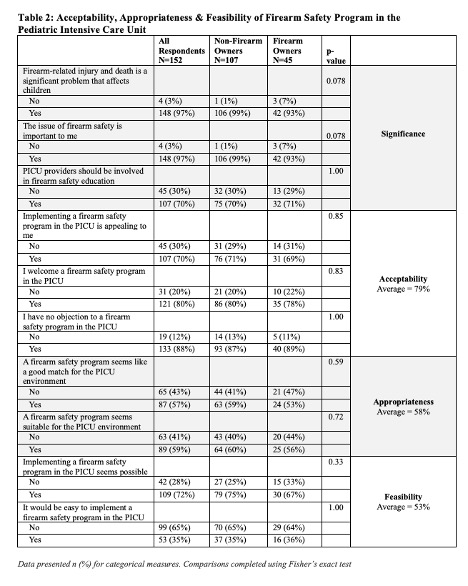Critical Care 2
Session: Critical Care 2
121 - Attitudes Surrounding Implementation of a Firearm Safety Program in the Pediatric Intensive Care Unit: A National Multi-center Survey
Friday, April 25, 2025
5:30pm - 7:45pm HST
Publication Number: 121.3714
Anireddy R. Reddy, Childrens Hospital of Philadelphia, Philadelphia, PA, United States; Laura Bricklin, Childrens Hospital of Philadelphia, Philadelphia, PA, United States; Michael C. McCrory, Wake Forest Baptist Health - Brenner Children's Hospital, Winston Salem, NC, United States; manzilat akande, Oklahoma Childrens Hospital at OU Health, oklahoma city, OK, United States; Julia A. Heneghan, University of Minnesota Masonic Children's Hospital, Minneapolis, MN, United States; Conrad Krawiec, Penn State Children's Hospital, Hershey, PA, United States; Grace Chong, Comer Children's Hospital at University of Chicago Medical Center, Chicago, IL, United States; Brian Flaherty, University of Utah School of Medicine, Salt Lake City, UT, United States; Salim Aljabari, university of arkansas, conway, AR, United States; Kayla B. Phelps, Louisiana State University School of Medicine in New Orleans, New Orleans, LA, United States; Charlotte Woods-Hill, Perelman School of Medicine at the University of Pennsylvania, Wilmington, DE, United States

Anireddy R. Reddy, MD, MSHP
Attending Physician
Childrens Hospital of Philadelphia
Philadelphia, Pennsylvania, United States
Presenting Author(s)
Background: Firearm-related injuries are the leading cause of death in children. Firearm safe storage counseling and gun lock distribution are evidence-based practices to reduce firearm injury and death, but with limited application in the pediatric intensive care unit (PICU). Prior single center data suggest that this practice is acceptable to PICU providers, however there are unique individual, institutional, and geographic factors which may influence attitudes.
Objective: We aimed to assess acceptability, feasibility, and appropriateness, as well as describe facilitators and barriers, to safe storage counseling across multiple pediatric critical care settings.
Design/Methods: We surveyed an interdisciplinary group of providers (attendings, fellows, advanced practice providers, hospitalists, pediatric surgeons, and social workers) across eight U.S. PICUs from August 15-October 15, 2024. The survey used the Acceptability of Intervention and Feasibility of Intervention (AIM-IAM-FIM) framework with a 5-point Likert scale. The average percentage of agreement (a score of 4 or 5) for each domain was used to describe the program as acceptable, appropriate, or feasible. Comparisons by firearm ownership status were completed using Fisher’s exact test. The most frequently selected facilitators and barriers to implementation were reported.
Results: The survey was sent to 213 PICU providers with 152 respondents (response rate 71%). Thirty percent of respondents reported a firearm in their household, with the majority (84%) being safely stored. While 97% of respondents believed firearm injury is a significant child health problem, only 70% believed that PICU providers should be involved in providing firearm safety education. Overall there was high acceptability (79%) but lower appropriateness (58%) and feasibility (53%) reported. There were no significant differences between firearm and non-firearm owners. Barriers identified were 1) insufficient time, 2) insufficient funds, 3) concern that families would not be accepting, and 4) that education is best done in another setting. Facilitators identified were 1) receiving training, 2) dedicated staff to provide education, and 3) stronger evidence for gun locks.
Conclusion(s): PICU providers reported that firearm safety is an important child safety issue. There was high acceptability, but lower appropriateness and feasibility, of safe storage counseling and gun lock distribution in the PICU. This multi-center contextual inquiry can be used to inform future implementation of firearm safety interventions in the PICU.
Table 1: Characteristics of PICU Provider Respondents
.jpg)
Table 2: Acceptability, Appropriateness & Feasibility of Firearm Safety Program in the Pediatric Intensive Care Unit


